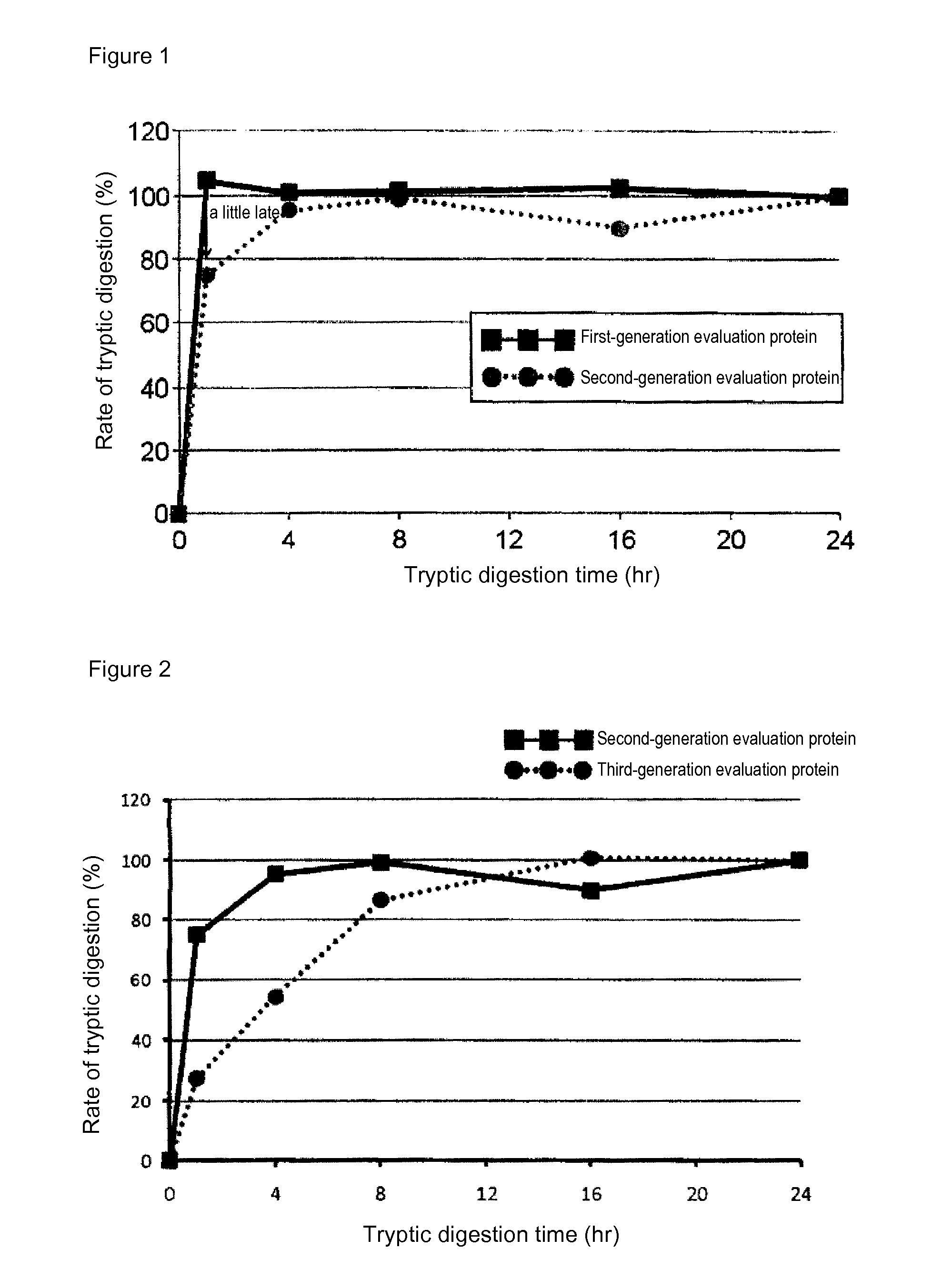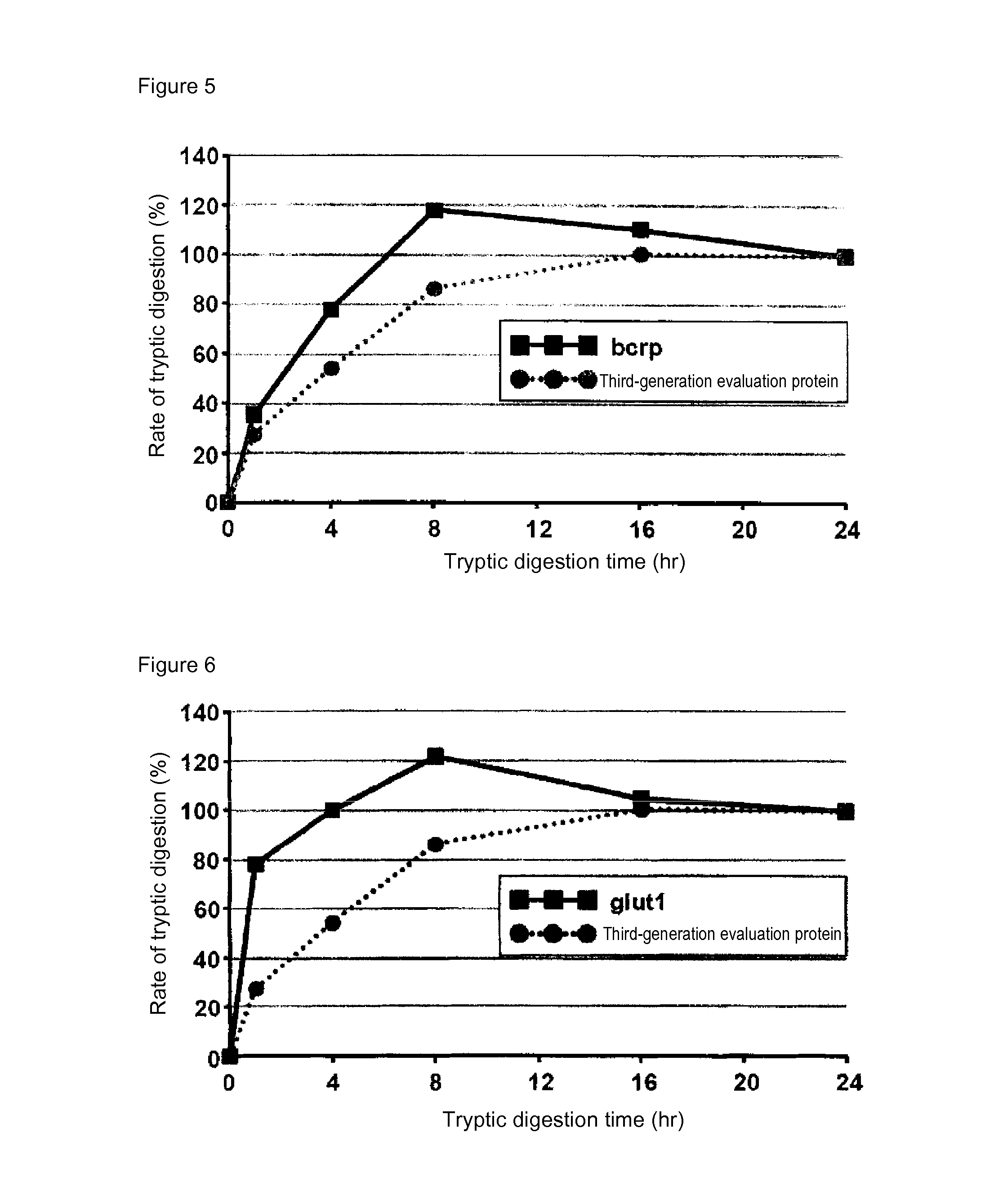Method for fabricating stable-isotope-labeled target peptide fragment in mass spectrometry
a mass spectrometry and target peptide technology, applied in the direction of peptide/protein ingredients, peptide sources, instruments, etc., can solve the problems of affecting the selection of the protein for evaluation, the inability to completely synthesize stable isotope-labeled protein, etc., to achieve excellent economics, confirm highly efficient digestion treatment, and excellent convenience
- Summary
- Abstract
- Description
- Claims
- Application Information
AI Technical Summary
Benefits of technology
Problems solved by technology
Method used
Image
Examples
example 1
Construction of Protein for Evaluation of the Present Invention
[0086]In mass spectrometry, the rate of digestion is calculated using a evaluation protein in order to evaluate the digestion efficacy by trypsin of proteins contained in a sample. Specifically, when the rate of digestion of the protein for evaluation is 100%, the analyte proteins can be evaluated as having been successfully assayed without a loss attributed to undigested proteins in the course of tryptic digestion treatment. In the case of using a conventional evaluation protein, however, analyte proteins having a low rate of tryptic digestion may not be completely digested even at 100% rate of digestion of the protein for evaluation. Thus, an attempt was made to produce a protein for evaluation whose complete digestion could serve as an indicator for evaluating analyte proteins as having been completely digested. For this purpose, membrane proteins generally regarded as having a low rate of digestion were screened for ...
example 2
Improvement in Fragmentation Treatment with Trypsin of the Present Invention
[0091]The present inventors considered improving the digestion method in order to enhance the rate of tryptic digestion of membrane proteins, which are indigestible proteins. Trypsin is an enzyme that hydrolyzes the carboxyl-terminal peptide bonds of lysine (K) and arginine (R). This enzyme has been thought to have lower cleavage efficiency for the lysine residue than that for the arginine residue. Thus, in this experiment, trypsin was studied for whether its combined use with lysyl endopeptidase (hereinafter, also referred to as “Lys-C”), an enzyme having the activity of cleaving lysine residues, allowed for efficient protein degradation (FIG. 7).
[0092]The cell membrane fraction prepared in Example 1 was digested with trypsin alone, and its rate of digestion was compared with the rate of digestion of the cell membrane fraction by 3-hour digestion with Lys-C followed by 16-hour tryptic digestion. The reactio...
example 3
Improvement in Method for Preparing Sample Containing Target Protein of the Present Invention
[0094]Since the cell membrane fraction contained large amounts of impurities, this seemed to be responsible for reduction in the rate of tryptic digestion. SISCAPA is known as a method for removing impurities. The SISCAPA method involves subjecting a protein sample to digestion treatment and concentrating the resulting peptide fragments by affinity purification using antibodies that recognize the peptide fragments (FIG. 11, left). The SISCAPA method can reduce impurities contained in the protein sample prior to mass spectrometry and can therefore increase the peak intensity of the peptide fragments to be detected. This method, however, requires antibodies against the target peptide fragments in each case and is therefore disadvantageous in terms of convenience. The present inventors considered that if target peptide fragments could be concentrated using antibodies recognizing proteins, a wid...
PUM
| Property | Measurement | Unit |
|---|---|---|
| time | aaaaa | aaaaa |
| time | aaaaa | aaaaa |
| flow rate | aaaaa | aaaaa |
Abstract
Description
Claims
Application Information
 Login to View More
Login to View More - R&D
- Intellectual Property
- Life Sciences
- Materials
- Tech Scout
- Unparalleled Data Quality
- Higher Quality Content
- 60% Fewer Hallucinations
Browse by: Latest US Patents, China's latest patents, Technical Efficacy Thesaurus, Application Domain, Technology Topic, Popular Technical Reports.
© 2025 PatSnap. All rights reserved.Legal|Privacy policy|Modern Slavery Act Transparency Statement|Sitemap|About US| Contact US: help@patsnap.com



